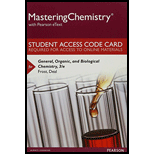
Concept explainers
a.
To determine:
The similarity in the conformational isomers.
Introduction:
Conformational isomers are the isomers that can be interconverted when there is a rotation in the single bonds. These isomers are a form of stereoisomers having the same connectivity but differ in the spatial arrangements. For example, gauche and eclipsed are the conformational isomers of one another.
b.
To determine:
The difference in the conformational isomers.
Introduction:
Conformational isomers are the isomers that can be interconverted when there is a rotation in the single bonds. These isomers are a form of stereoisomers having the same connectivity but differ in the spatial arrangements. For example, gauche and eclipsed are the conformational isomers of one another.
Want to see the full answer?
Check out a sample textbook solution
Chapter 4 Solutions
Mastering Chemistry with Pearson eText -- Standalone Access Card -- for General, Organic, and Biological Chemistry (3rd Edition)
- Explain the concept of Energy Changes and Conformational Analysis ?arrow_forward(a) how many stereoisomers are possible? (b) how many chiral carbons are in the structure? (c) is this optically active?arrow_forwardWhat is the difference between a constitutional, confirgurational, and a conformational isomer?arrow_forward
- Give A Summary about Isomers ?arrow_forwardHow many chiral canters do we have in the structure?arrow_forwardCategorize each pair of structures using all the terms that apply: Identical, isomers, constitutional isomers, conformational isomers, stereoisomers, enantiomers, and diastereomers. Molecular models can be very useful for thisarrow_forward
- I don’t understand, what is the difference between conformational structures of a molecule and different structural isomers? Could you please show an example as well? Thanksarrow_forwardisomers and different conformationsarrow_forward(a) How many chiral carbons are present in the compound below in the picture? Mark the chiral carbons with an asterisk (*). (b) How many total optical isomers are possible for the structure below in picture?arrow_forward
- Show a concept map of how isomers are utilized in various fields in life. Example: medicine, transportation, agriculture etc. and explain how isomers were utilized in various fields in life.arrow_forwarda. For the compound below show how its carbon skeleton can be divided into isoprene units b.Put a star next to every chiral carbon in the moleculearrow_forwardThe structures below are: A) not isomers.B) conformational isomers.C) cis-trans isomers.D) structural isomers.E) both B and Darrow_forward
 Living By Chemistry: First Edition TextbookChemistryISBN:9781559539418Author:Angelica StacyPublisher:MAC HIGHER
Living By Chemistry: First Edition TextbookChemistryISBN:9781559539418Author:Angelica StacyPublisher:MAC HIGHER
